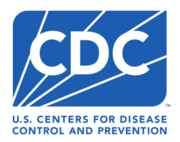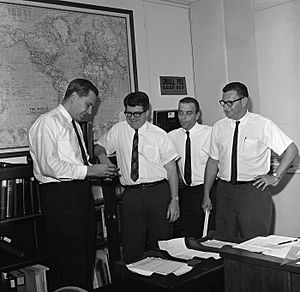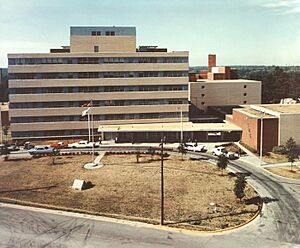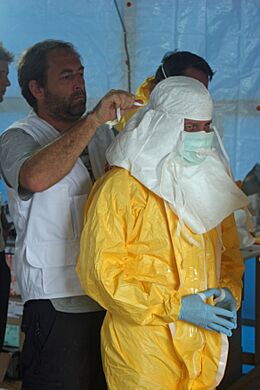Centers for Disease Control and Prevention facts for kids
 |
|
| Agency overview | |
|---|---|
| Formed | July 1, 1946 |
| Preceding agencies |
|
| Jurisdiction | Federal government of the United States |
| Headquarters | Atlanta, Georgia, U.S. 33°47′58″N 84°19′42″W / 33.79944°N 84.32833°W |
| Employees | 11,814 |
| Annual budget | US$11.581 billion (FY24) |
| Agency executives |
|
| Parent agency | United States Department of Health and Human Services |
The Centers for Disease Control and Prevention (CDC) is America's top agency for protecting the nation's health. It is part of the United States Department of Health and Human Services and is based in Atlanta, Georgia.
The main goal of the CDC is to keep people safe and healthy. It works to control and prevent diseases, injuries, and disabilities in the United States and around the world. The CDC focuses on many health topics, like infectious diseases, illnesses from food, and health issues caused by the environment.
The CDC also helps people learn how to live healthier lives. It researches and shares information on conditions like obesity and diabetes. The agency is a key member of the International Association of National Public Health Institutes, working with other countries to improve global health.
Contents
History of the CDC
The CDC has a long history of protecting public health and has grown a lot since it first started.
How the CDC Began
The CDC was founded on July 1, 1946. It grew out of a program from World War II that worked to stop the spread of malaria, a disease carried by mosquitoes. Because malaria was a big problem in the Southern United States, Atlanta was chosen as the agency's home.
When it started, the agency was called the Communicable Disease Center. It had a small budget and about 400 employees. Most of them were engineers and entomologists (scientists who study insects). Their main job was to control mosquitoes to get rid of malaria in the U.S.
In 1947, the CDC bought land for its headquarters from Emory University for only $10. This land is still where the CDC's main campus is today.
Growing and Expanding
Over the years, the CDC's mission grew. In 1951, it created the Epidemic Intelligence Service (EIS). This program trains "disease detectives" who travel the world to investigate and stop disease outbreaks. This idea was so successful that many other countries started similar programs.
The CDC also began to work on other health problems. It added programs for tuberculosis in 1960 and immunization (vaccines) in 1963.
The agency's name changed several times as it grew. In 1980, it became the Centers for Disease Control to show that it was made up of many different centers, each with its own focus.
Recent History
In 1992, Congress added "and Prevention" to the agency's name, making it the Centers for Disease Control and Prevention. However, everyone still calls it the CDC because the name is so well-known.
Since the 1990s, the CDC has focused on even more health issues. These include long-term illnesses (called chronic diseases), disabilities, and preventing injuries. It also works on keeping workplaces safe and preparing for health threats like bioterrorism.
The CDC has some of the world's most secure labs, called Biosafety Level 4 labs. These labs are used to study the most dangerous germs. The CDC's lab in Atlanta is one of only two places in the world that officially stores the smallpox virus. The other is in Russia.
After the COVID-19 pandemic, the CDC announced in 2022 that it would make big changes. The agency said it needed to get better at sharing information with the public and responding faster to health emergencies.
Organization and Locations
The CDC is made up of many different centers, institutes, and offices. Each one specializes in a specific area of health, like vaccines, injuries, or environmental health.
Most of the CDC's offices are in the Atlanta, Georgia, area. It also has other locations across the United States, including in Maryland, North Carolina, and West Virginia. The CDC has staff working in more than 60 countries around the world to help with global health problems.
What the CDC Focuses On
The CDC works on hundreds of diseases and health threats to keep people safe.
Communicable Diseases

A big part of the CDC's job is to fight communicable diseases, which are illnesses that can spread from person to person. This includes diseases like the flu, measles, and Ebola.
The CDC has a special program to handle very dangerous germs, like anthrax. This program inspects labs in the U.S. to make sure they are handling these materials safely. During the 2014 Ebola outbreak in West Africa, the CDC helped bring infected American aid workers back to the U.S. for treatment.
Non-Communicable Diseases
The CDC also works to prevent non-communicable diseases. These are conditions that don't spread from person to person, like heart disease and cancer. Many of these are linked to lifestyle choices, so the CDC promotes healthy habits like eating well and being active.
Global Health
Health problems can cross borders, so the CDC works with partners around the world, like the World Health Organization (WHO). They help other countries track and stop diseases before they can spread internationally. The CDC is also a key partner in major global health programs that fight diseases like HIV and malaria.
Health Information for Travelers
If you're planning a trip to another country, the CDC has information to help you stay healthy. It publishes a "yellow book" with health advice, vaccine recommendations, and tips for travelers. The CDC also posts travel health notices on its website to warn people about disease outbreaks in other parts of the world.
Vaccine Safety
The CDC closely monitors the safety of vaccines in the United States. It runs programs like the Vaccine Adverse Event Reporting System (VAERS) with the FDA. This system collects reports of possible side effects after vaccination to spot any potential problems early. The CDC's website provides clear information on vaccine safety and answers common questions.
CDC Leadership
The director of the CDC is the head of the agency. This person is chosen by the President and must be approved by the Senate. The director leads the CDC in its mission to protect public health. Many different directors have led the CDC throughout its history, each facing different health challenges.
See also
 In Spanish: Centros para el Control y Prevención de Enfermedades para niños
In Spanish: Centros para el Control y Prevención de Enfermedades para niños
- ATSDR – CDC department
- NIOSH – CDC department
- List of national public health agencies
- Safe Kids Worldwide



